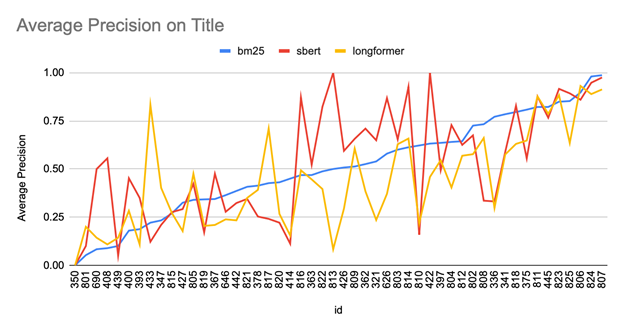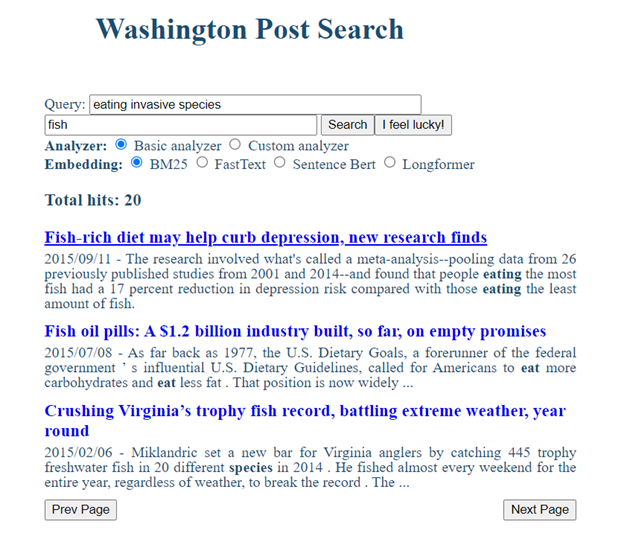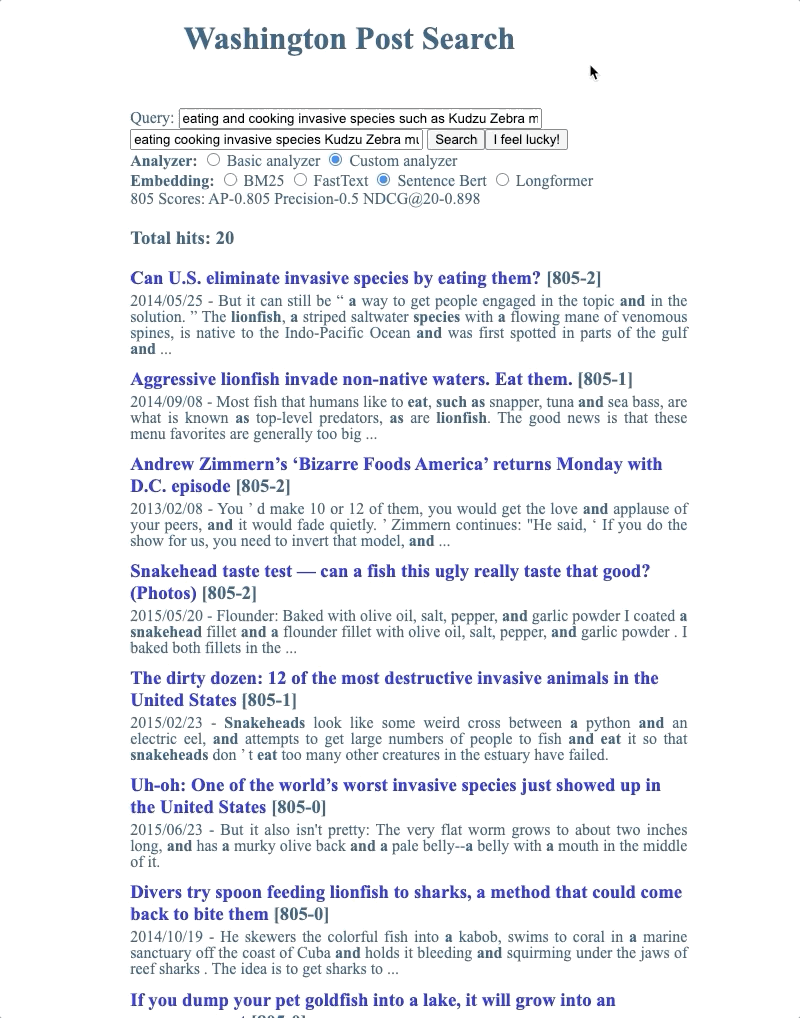This repository is for the final project of COSI 132A, Information Retrieval. We used TREC as our annotated dataset to build a news article search engine that can retrieve documents relevant to a user query on a topic.
System demo, searching for articles related to our topic of interest, "Eating Invasive Species":
Team members: Yonglin Wang, Xiaoyu Lu, Yun-Jing Lee, Ruobin Hu
Team member submitting code: Xiaoyu Lu
In this TREC-based information retrieval project, we experimented with computer-assisted query expansion, reranking with Longformer embedding, keyword bolding, and web UI improvements. This project is built based on a ES system we previously developed in class, which uses BM25 and a custom analyzer for document retrieval and fastText and sBERT embedding for reranking.
This amazing project cannot be put together without the contribution of each group member! The order below corresponds to the order in which we speak in our final presentation.
Yonglin: Longformer, query expansion, search by keyword
Yun-Jing: corpus-wide and topic-level data analysis
Ruobin: web UI, on call CSS styling
Xiaoyu: text bolding algorithm, database
Here is a list of progress reports, sorted by recency:
To request access to our group project Drive folder containing all the documentations and essential datasets, please contact one of the group members.
In this project, we specifically evaluated the effect of our approaches on one of TREC 2018 topics, #805, which includes the following fields:
<top>
<num> Number: 805 </num>
<title>
eating invasive species
</title>
<desc> Description:
Would eating invasive species be a viable method of controlling/eradicating them?
</desc>
<narr> Narrative
Relevant documents identify invasive species in the U.S. that can be eaten by human beings and discuss the likelihood of controlling the species through consumption. Comments on the color, taste, texture, or other culinary qualities of particular invasive species are also relevant.
</narr>
</top>Each query below builds on the previous one; additional terms are underlined.
-
Default Title: eating invasive species
-
Wiki (adding Wikipedia species expansion): eating invasive species Kudzu Zebra mussel Asian carp Snakehead Giant African land snail Lionfish
-
Wiki + Cook (adding GloVe informed synonym for eating): eating cooking invasive species Kudzu Zebra mussel Asian carp Snakehead Giant African land snail Lionfish
-
Wiki + Cook + NL (Natural Langauge) (adding functional words to reranking query): eating and cooking invasive species such as Kudzu Zebra mussel Asian carp Snakehead Giant African land snail and Lionfish
For more queries, see our discussion in the final report.
In the following table, we can see that each new technique proposed brings improvement in two or all of the scores. All best results are from using custom analyzer and BM25 for retrieval and sBERT for reranking.
| Score Type | Wiki + Cook + NL rerank | Wiki + Cook | Wiki | PA Best (Default Title) |
|---|---|---|---|---|
| AP | 0.837 | 0.772 | 0.659 | 0.533 |
| Precision | 0.5 | 0.5 | 0.45 | 0.35 |
| NDCG@20 | 0.917 | 0.836 | 0.772 | 0.695 |
The result for our Average Precision of retrieving with title text for each TREC topic:
From this graph, we can see that no one single embedding method outperforms others across topics. Which embedding to use for reranking seems to depend on the content of the query. Therefore, in the future, it would be beneficial to cluster queries based on their content and other characteristics and determine which embedding method to apply to which cluster of queries.
Below is the screenshot for our Web UI Home Page, note that "I feel lucky!" will choose a random Analyzer + Embedding combination for the user, in order to reduce the friction in deciding on a combination:
Below is the screenshot for our Web UI Result Page, where we first retrieve by the keyword "fish" and rerank the retrieved documents with "eating invasive species", note that
- the title link shows underline when cursor hovers over.
- the snippets highlights the keywords in the reranking query, regardless of morphological inflections (e.g. "eat" is also highlighted while only "eating" is present in the query)
Below is the screenshot for our Web UI Result Page with Debug Mode using Wiki + Cook query for retrieval and Wiki + Cook + NL query for reranking, note that
- AP (Average Precision), Precision, and NDCG (Normalized Discounted Cumulative Gain) are now shown.
- relevance annotations (805-1 = relevant to Topic 805; 805-2 = highly relevant to Topic 805; 805-0, other topic ID, or no annotation = not relevant to Topic 805) now appears on the right of the title link.
Below is the screenshot for our Web UI Doc Page, where we display the content of the WAPO article after the user clicks on its title on the result page.
For a detailed result discussion, see our discussion in the final report.
- Taking intersections on Wikipedia data helps narrow down keywords
- Reranking with a different text might help, especially when expanding query terms
- Implementing Longformer to include more document texts might be helpful, depending on the topic
- Longformer sometimes helps with reranking BM25 results
- Separate input texts for retrieving and reranking
- Keyword bolding algorithm is much harder than it looks
- User-centric UI design
This repository is Python-based, and Python 3.9 is recommended.
Remember to always activate your virtual environment first. You can create a virtual environment using either venv or conda.
The required packages are listed in requirements.txt.
Run the following subsections only once, when you set up the project for the first time.
pip install -r requirements.txtAfter you install elasticsearch-dsl-py package, add the following code at the end of elasticsearch_dsl/query.py:
class ScriptScore(Query):
name = "script_score"
_param_defs = {"query": {"type": "query"}}Download ES from https://www.elastic.co/downloads/past-releases#elasticsearch. Make sure you are choosing Elasticsearch 7.10.2 (used for scoring the assignment). To start the ES engine:
cd elasticsearch-7.10.2/
./bin/elasticsearchYour data/ directory should contain the following files, so that you can run the system properly:
data
├── docs50k_whole.db
├── subset_wapo_50k_sbert_ft_lf_filtered.jl
├── topics2018.xml
└── wiki-news-300d-1M-subword.vec
You can download wiki-news-300d-1M-subword.vec at any time here.
After granted access by one of our team members, you can access:
docs50k_whole.db: database for the keyword bolding algorithm
subset_wapo_50k_sbert_ft_lf_filtered.jl: JSON line file containing a subset of documents in TREC, including their sBERT, fastText, and Longformer vectors
To load wapo docs into the index called "wapo_docs_50k_lf", run:
python load_es_index.py --index_name wapo_docs_50k_lf --wapo_path data/subset_wapo_50k_sbert_ft_lf_filtered.jlThis is just for documentation purpose. You DO NOT need to run the code described here, since your data/ directory should have the datasets already by now.
-
Dataset:
subset_wapo_50k_sbert_ft_lf_filtered.jlCode for creating: longformer_vectorization
Instructions: see longformer_vectorization; GPU resources are recommended.
-
Dataset:
docs50k_whole.dbCode for creating: db.py
Instructions:
To get a taste of the time it takes (~1 hour) to build db from all documents, you can create the database by running
python db.py
Make sure the code under
if __name__=="__main__":in db.py is all uncommented before creating databases.
If you haven't done so already, run the following command to start an ES server:
cd elasticsearch-7.10.2/
./bin/elasticsearchYou don’t need to download any pretrained model for sentence transformers, it will be loaded the first time it's called.
- Load fasttext model (click this link to download
.vecfile first, then put it intodata/folder):
python -m embedding_service.server --embedding fasttext --model data/wiki-news-300d-1M-subword.vec- Load sbert model:
python -m embedding_service.server --embedding sbert --model msmarco-distilbert-base-v3- Load longformer model (download for the first time):
python -m embedding_service.server --embedding longformer --model allenai/longformer-base-4096-
For Evaluation: Change
TOPIC_IDto the topic ID you want to evaluate.sh scirpts.sh
-
For the web app:
Run the app, then type http://127.0.0.1:5000/ in the browser to view the web application.
python app.py
If you'd like to see scores for Topic 805 and annotations on the result page, run
python app.py --debug
Our BM25 retrieval system defaults to using keyword text and falls back to query text if no keyword text is provided. If neither keyword nor query text is provided, the program will jump back to home page.
Reranking will only be performed if query text is provided and reranking is based on query text only.
The top K results will be retrieved based on the keyword text and, if reranking, reranked based on the query text.
The top K results will be retrieved based on the query text and, if reranking, reranked based on the query text as well.
This is the default behavior in PA5.
The top K results will be retrieved based on the keyword text.
Intuitively, no reranking will be performed even if a reranking method is specified. This means that if a user searches with only keywords and chooses fastText as the reranking method, the system will correct the reranking method to BM25 only (i.e. no reranking).





